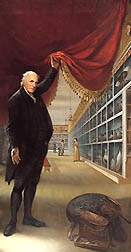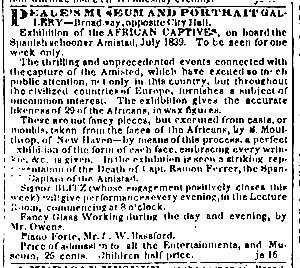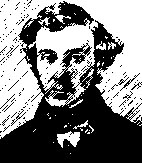Chapter XI: 1827 - William Paulding, Mayor
. . . Washington Square was opened, great part of which
had been occupied as the Potter's Field, the remainder, about
31/2 acres, being purchased for $78,000. . . .
 |
| The Visual or Shutter Telegraph that gained wide use on both sides of the Atlantic during the era about which Charles Haswell wrote in this chapter had been developed by Lord George Murray. Operating from the 1790s, the system consisted of a series of stations, usually placed high up, often atop towers and hills, where with a telescope each operator usually could see at least two other stations, one in a distant horizon on either side of his own station. Atop each station was a platform on which stood a large board with 6 large circular holes that could be closed by shutters. Arranged in three pairs, one above the other, they looked like the dots on the "6" face of a die. The 63 possible combinations of closed and open holes transmitted short semaphore messages hundreds of miles in a matter of minutes. The messages might originate from a ship or be sent to one. Many a location still known as Telegraph Hill derives its name from when it was part of that communication system. |
It was now seriously urged by many that the city
could be supplied with sufficient pure and wholesome water from
the Bronx River, since it was computed that it would furnish above
four million gallons per diem; and by the lowering of Rye Pond
and the aid of dams, etc., nearly nine million gallons could be
obtained.
Hack fares at this date were twentyfive cents
a single passage for any distance not exceeding one mile; for
more than a mile, fifty cents; additional passengers twentyfive
cents each.
Evan Jones of 53 White Street commenced running a
line of stages from Broadway and Houston Street to Wall Street.
Abraham Brower of 661 Broadway also put on a line from the corner
of Houston Street and Broadway to Wall Street, corner of William.
In a few years after he replaced his early stages with new, larger,
and more convenient ones, drawn by four horses. When the streets
were sufficiently covered with snow, the stages were replaced
with large sleighs drawn by four or six horses, and the frolics
of a country sleighride were moderately indulged in. For
full thirty years these great sleighs were a striking winter characteristic
of Broadway. . . .
The Common Council considered the construction of
a market at the foot of Canal Street and one (the Clinton) was
finally located there; it also proposed to close the sewer in
Maiden Lane and lead the surface water to the side gutters. . . .
March 12 Jacob Barker was tried for libel, and convicted
on the 10th of the following month. . . .
Third, Seventh, Tenth, and Twentyfirst streets
were ordered to be opened on May 1. . . .
 |
| Charles Willson Peale, the Federal period's most prominent portraitist, formed the first scientific expedition in American history when in 1801 he led an exploration into upstate New York where he exhumed a mastodon skeleton, assembling and restoring the remains for the museum that he had established in Philadelphia five years earlier. Peale's Museum in New York was established in October, 1825 and run by one of the Peale sons, Rubens, a still-life painter. Above is the main section from a self-portrait by Charles Willson Peale showing off his natural history museum, America's first. The portrait is featured among the University of Minnesota's excellent web pages on Natural History in the Public Domain, including a half-dozen on Peale's contributions. |
May 1 the Merchants' Exchange building in Wall Street
was opened. July 4 the Post office was installed in part of the
basement of this building; rent of letter boxes four dollars per
annum. Following the completion of the Exchange the marine telegraph
previously communicating from Staten Island to the Battery was
extended from Wall Street to Sandy Hook via Staten Island. My
readers will of course understand not the modern telegraph familiar
to them, but the oldfashioned instruments for signalling
to the eye aided by a telescope.
May 8 Captain John B. Nicholson, U.S.N., presented
the city with four granite balls which were alleged to have been
taken from the ruins of Troy; they were set upon the four granite
columns at the gates leading to the southern entrance to the Park.
The Legislature constructed the Thirteenth ,and fourteenth
Wards.
May 24, in consequence of the unusual number of strangers
visiting the city, from the somewhat diverse causes of the yearly
meetings of the Quakers and the coming races at the Union Course,
the papers of the day published a list of the places of interest
to visitors. To illustrate the difference in the number and character
of these between that time and the present I recite those that
were given; viz.,
- American Academy of Arts,
- Brouwer's Gallery of Busts,
- Scudder's and Peale's Museums,
- Spectaculum in Chatham Street,
- Athenaeum,
- City Library,
- Automatic Chess Players,
- Sea Serpent, Dwarf, and Wonderful Ox.
There were two museums in full operation at this time; viz., Scudder's in the City Almshouse, before referred to, and Peale's in Broadway. Each sported a band of music with which to beguile visitors, and each vied with the other in the effectiveness and supremacy of their bands. When one opened with "The Star Spangled Banner," the other
was sure to follow with "Yankee Doodle."
Probably in musical quality these bands may not have been superior to the later one of Barnum, which daily blew with great persistency from
the gallery of the American Museum at Broadway and Ann Street. . . .  |
| The New York Commercial Advertiser on June 16, 1840, ran an ad that read, in part:
"PEALE'S MUSEUM AND PORTRAIT GALLERY -- Broadway, opposite City Hall. "Exhibition of the AFRICAN CAPTIVES, on board the Spanish schooner Amistad, July 1839. To be seen for one week only. The thrilling and unprecedented events connected with the capture of the Amistad, which have excited so much public attention, not only in this country, but throughout the civilized countries of Europe, furnishes subject of uncommon interest. The exhibition gives the accurate likeness of 29 of the Africans, in wax figures . . . . taken from the faces of the Africans, by S. Moulthrop, of New Haven -- by means of this process, a perfect exhibition of the form of each face, embracing every wrinkle, &c., is given. In the exhibition is seen a striking representation of the Death of Capt. Ramon Ferrer, the Spanish Captain of the Amistad. . . . Price of admission . . . 25 cents. Children half price."
For more newspaper clippings on the Amistad in general and the exhibit at Peale's in particular, visit Mystic Seaport's informative web page
Timeline: The Amistad Revolt. |
Street gaslamps were first lighted in this
month
July 4 the "Bowery" Theatre was opened
for a day performance for the first time, and this was the first
theatrical matinee ever given in this country. On this
day Negro slavery in the State was abolished.
August 27 Cliff Street was opened from Ferry into
Skinner, and both were known as Cliff Street thenceforth. Cheapside
was changed to Hamilton Street. . . .
Boston Road from One Hundred and Twentyfifth
Street to Harlem River, was closed in this year. Henry Street
was widened. The Manhattan Market at Goerck, Rivington, Stanton,
and Mangin streets was built. This market was named after the
neighboring Manhattan Island, and I may explain here to the young
gentlemen from the country who furnish the "city news"
for most of our newspapers, and in doing it betray no knowledge
of the town earlier than that acquired the year before, that Manhattan
island and the Island of Manhattan are very different things.
The former title was given to a knoll of land lying nearly within
the lines of the present Houston, Third, and Lewis streets, which
at very high tides was insulated. For many years the name was
by extension applied also to the nearby territory; that
part of the city lying adjacent to the knoll being familiarly
termed Manhattan Island.
The editorial staff of the New York Mirror and
Ladies' Literary Gazette, being
added to by Gulian C. Verplanck, Charles Fenno Hoffman, and James
Fenimore Cooper, the paper was popular and well patronized.
September 13. The Law Committee of the Board of Aldermen
recommended the erection of an additional or Superior Court and
the appointment of a Vicechancellor. . . .
At a meeting of citizens a committee of fourteen
was appointed to select a delegation from its number to proceed
to New Orleans on the 8th of January ensuing (the anniversary
of the battle of New Orleans), and present its congratulations
to General Andrew Jackson; and Messrs. Saul Alley, Thaddeus Phelps,
and James A. Hamilton were selected. . . .
October 28 a duel was fought under the bluff at Weehawken
Heights on a spot then and for some time afterward well known
as the duellingground; it was there General Alexander Hamilton
fell in his duel with Aaron Burr, Richard Riker was wounded by
Robert Swartwout, and General Swartwout and Wm Maxwell and others
had fought. The parties were Wm G. Graham, associate editor with
M. M. Noah in the New York Enquirer, seconded by Louis
Atterbury, and a Mr. Barton of Philadelphia, seconded by Wm. F.
McLeod. Mr. Graham falling at the second fire, his body was ferried
across the river to about Fortysecond Street, or the French
tan-yards, as the locality was termed. . . .
December 11 Timothy B. Redmond, proprietor of the
United States Hotel in Pearl Street (not the present hotel in
Fulton Street), who had been arrested on an indictment for robbery,
was arraigned, and his trial postponed. This is mentioned from
the circumstance that on his trial at a later date (January 17)
it appeared that his arrest, imprisonment, and trial were solely
due to his resemblance to a noted thief. From the time of his
arrest to that of his acquittal the case was the cause of much
discussion and speculation, as there was a large number of our
citizens who were disposed to believe him guilty. He was honorably
acquitted, however, in the January following.
 |
| William Cullen Bryant |
Some hotelkeepers and friends subscribed and
gave him a dinner, and some time afterward "Old Hays,"
as he was known, arrested a man who proved to be the one who had
forged and presented the checks. On examination he proved to resemble
Redmond in a very decided manner. In the interval between his
incarceration and trial many stories were related of acts of Redmond,
which were all construed as evidence of a previous course of criminality,
and he was socially and financially ruined.
 |
| Hugh Maxwell, mentioned in this Haswell chapter, served a decade as DA and was among NY criminal justice leaders interviewed by Alexis de Tocqueville [sketch above], and Gustave de Beaumont, official emissaries sent by France to study American prisons. He particulary discussed with them the "House of Refuge" system designed to reform juvenile delinquents. |
William C. Bryant, who came to the city in 1826,
became a partner and associate editor in the Evening Post.
December 18 Henry Eckford, considering himself aggrieved
by the manner in which the District Attorney, Hugh Maxwell, had
conducted the prosecution against him and others (before referred
to), and some subsequent offensive declarations as alleged, caused
a challenge to be delivered to him, which was declined. . . .
The Journal of Commerce on September 1 was
established by Arthur Tappan as a great moral and abolition paper,
and it was announced that lottery and like notices and advertisements
would be excluded. In 1828 it was purchased and edited by Hale
& Hallock, absorbing The Times, which had been published
for a brief period before. The publication office was at No. 2
Merchants' Exchange, and work was not permitted in it between
12 P.M., Saturday, and 12 P.M., Sunday. The Journal of Commerce
and the Enquirer, in their competitive efforts to publish
the first news of arrivals by sea, employed small sailing vessels
to cruise off Sandy Hook, carrying reporters to board the incoming
ships. . . . When the Exchange was completed, Exchange Street to Broad was named Exchange Place.
An association of ladies, members of the Wall Street
Church, organized a Sundayschool some years previous to
this; but it was in this year absorbed by the American Sundayschool
Union. . . .
The secretary of an insurance company in this city,
who was afflicted with the gambling mania, lost in one evening
a sum said to have exceeded fifty thousand dollars; soon after
it was discovered he was deficient fully three times that amount;
the directors caused him to be arrested and imprisoned and soon
after he committed suicide.
|






